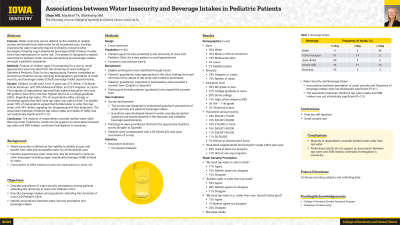Preventive
428 - Associations between Water Insecurity and Beverage Intakes in Pediatric Patients

- MO
Maya Olson, B.S. (she/her/hers)
Dental Student
University of Iowa, Iowa City, IA
Iowa City, Iowa, United States - TM
Teresa A. Marshall, PhD, RDN/LDN
University of Iowa College of Dentistry and Dental Clinics
- HS
Heidi M. Steinkamp, DDS, MS, PhD
University of Iowa College of Dentistry and Dental Clinics
- TM
Teresa Marshall, PhD, RDN/LDN
Professor
University of Iowa College of Dentistry and Dental Clinics
Iowa City, Iowa, United States
Presenting Author(s)
Co-Author(s)
Program Director(s)
Purpose: Water insecurity can be defined as the inability to reliably access and benefit from safe water for all household uses. Families experiencing water insecurity may be inclined to consume other beverages including sugar-sweetened beverages (SSB) instead of water, which has implications for caries risk. This project is designed to explore associations between water security perceptions and beverage intakes amongst a pediatric population.
Methods: Parents of children aged 2-8 presenting for a new or recall appointment were recruited from the University of Iowa College of Dentistry’s Pediatric Clinic for an ongoing study. Parents completed an anonymous Qualtrics survey querying demographics, perception of water security, and beverage intakes (Child’s beverage Intake Questionnaire).
Results: Children (n=44) were 5.6±1.3 years old; 57% White, 21% Black/African American, and 18% Multiracial/Other; and 23% Hispanic or Latinx. The majority of respondents reported their highest education level was 8th grade or less (30%); the next highest level was a college graduate (28%). Regarding tap water, 70% of respondents either strongly or somewhat agreed that their local tap water was safe to drink. For bottled water, 55% of respondents agreed that bottled water is safer than tap water, with 34% neither agreeing nor disagreeing with that statement. The association between children’s tap water intake and intake of SSBs was not statistically significant (P=1.0).
Conclusion: The majority of respondents consider bottled water safer than tap water. Preliminary results do not support an association between tap water and SSB intakes; continued investigation is necessary.
Identify Supporting Agency and Grant Number:

.jpg)